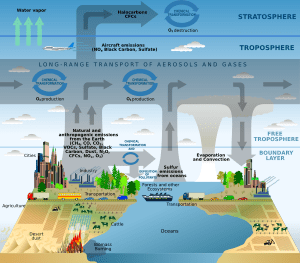Atmospheric chemistry facts for kids
Atmospheric chemistry is a science that studies the air around Earth and other planets. It uses ideas from many other sciences. These include environmental chemistry, physics, meteorology (weather science), computer models, oceanography (ocean studies), geology (Earth studies), and volcanology (volcano studies). It also connects with the study of climate.
Atmospheric chemists look at how the air affects living things. The air around Earth changes because of natural events. These include volcano eruptions, lightning, and particles from the Sun. Human activities also change the air. Some of these changes are harmful to people, crops, and ecosystems. Examples include acid rain, ozone depletion (the ozone layer getting thinner), photochemical smog, and global warming caused by greenhouse gases.
Atmospheric chemists study what causes these problems. They suggest ideas about them, then test these ideas and possible solutions. They also watch how changes in government rules affect the air.
Contents
What is Our Air Made Of?

The air we breathe is mostly made of two gases: Nitrogen and Oxygen. There are also smaller amounts of other gases. The amount of water vapor in the air changes a lot.
| Main Gases in Dry Air | ||
|---|---|---|
| Gas | Amount (about) | |
| Nitrogen, N2 | 78.084% | |
| Oxygen, O2 | 20.946% | |
| Argon, Ar | 0.934% | |
| Smaller Amounts of Gases (parts per million) | ||
| Carbon dioxide, CO2 | 383 | |
| Neon, Ne | 18.18 | |
| Helium, He | 5.24 | |
| Methane, CH4 | 1.7 | |
| Krypton, Kr | 1.14 | |
| Hydrogen, H2 | 0.55 | |
| Water | ||
| Water vapor | Changes a lot; usually about 1% | |
The amounts of CO2 and CH4 can change with the season and location.
A Look Back at Air Chemistry
People in Ancient Greece thought air was one of four basic elements. Scientists started studying what air was made of in the 1700s. Chemists like Joseph Priestley, Antoine Lavoisier, and Henry Cavendish were among the first to measure the air's makeup.
Later, in the 1800s and early 1900s, scientists became interested in gases found in very tiny amounts. A key discovery was ozone, found by Christian Friedrich Schönbein in 1840.
The amounts of these tiny gases in the air have changed over time. So have the chemical processes that create and destroy them. For example, Sydney Chapman and Gordon Dobson explained how the ozone layer forms and stays healthy. Arie Jan Haagen-Smit explained how photochemical smog forms. More studies on ozone led to the 1995 Nobel Prize in Chemistry. It was shared by Paul Crutzen, Mario Molina, and Frank Sherwood Rowland.
Today, atmospheric chemistry is seen as part of the larger Earth system. Scientists used to study it alone. Now, they study how air chemistry connects with the rest of the atmosphere, the biosphere (living things), and the geosphere (Earth's solid parts). This is because chemistry and climate are closely linked. For example, a changing climate and the healing of the ozone hole affect each other. Also, the air's makeup interacts with the oceans and land ecosystems.
How Scientists Study Air Chemistry
Scientists use three main ways to study atmospheric chemistry: observations, lab measurements, and computer models. These methods often work together. For example, if observations show more of a chemical than expected, it can lead to new lab and modeling studies. This helps scientists understand the air better.
Observing the Air
It is important to watch the air's chemistry over time. This helps scientists see any changes. The Keeling Curve is a good example. It shows measurements from 1958 until today. These measurements show a steady rise in carbon dioxide levels.
Scientists observe air chemistry from special places called observatories. One famous one is on Mauna Loa in Hawaii. They also use moving platforms like airplanes, ships, and balloons. More and more, satellites are used to observe air chemistry. This gives a global view of air pollution and chemistry.
Observations from the ground give long-term records. They show details over time. But they only cover a small area. Some ground tools, like LIDAR, can show how much of a chemical is at different heights. But they are still limited in how far they can see sideways. Many observations are shared online for everyone to see.
Measuring in the Lab
Lab measurements are key to understanding where pollutants come from and where they go. They also help us understand natural compounds. Lab studies show which gases react with each other and how fast. Scientists measure reactions in gas, on surfaces, and in water.
They also study photochemistry. This is about how quickly sunlight breaks molecules apart and what new chemicals are made. Scientists also study thermodynamic data. This includes things like Henry's law coefficients, which describe how gases dissolve in liquids.
Images for kids
-
Chemical composition of atmosphere according to altitude. Axis: Altitude (km), Content of volume (%).
See also
 In Spanish: Química de la atmósfera para niños
In Spanish: Química de la atmósfera para niños



